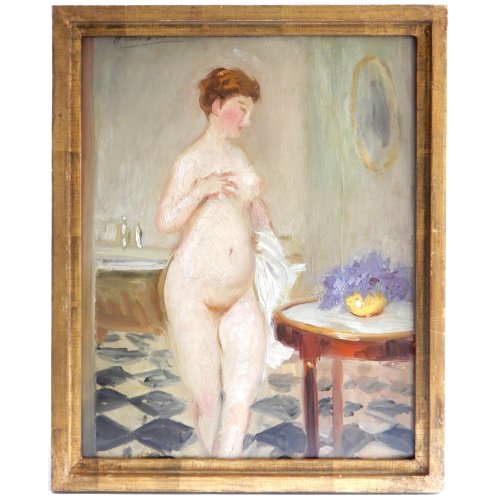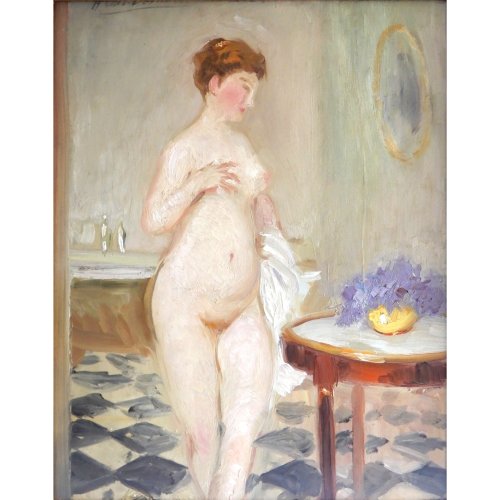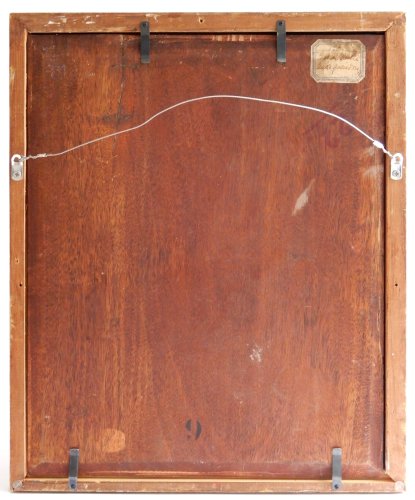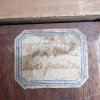Henry Caro-Delvaille (1876-1926) 'Nu a la toilette'
About this piece
Intimate and lovely oil painting on panel (wood), depicting a woman who has just taken a bath. It is a domestic scene that Henry Caro-Delvaille wanted to capture. The style of painting is different, but the atmosphere is reminiscent of the work of Pierre Bonnard (1867-1947). They also exhibited together with the Group "Les Intimistes" in 1906.
This work was painted in the early 1900s and was part of the famous Sommaruga Collection in Milan.
It is signed top left with 'H. Carol Delvaille.
Biography:
Henry Caro-Delvaille (Bayonne, 1876 - Paris, 1926) was a painter of elegant interiors, figures and nudes, he was especially known as a painter of women, always elegant and often intimate.
He was also an engraver and decorator. After studying at the École des Beaux Arts in Bayonne, he continued his education at the École des Beaux-Arts in Paris, Léon Bonnet became his mentor.
He won his first medal at the Salon des Artistes Française in 1901, where he made his debut in 1899. From 1903 he was a member of La Société Nationale des Beaux-Arts.
In 1905 he won the grande Medaille d'Or at the Exposition Internationale in Munich. This brought him a lot of success, he received many assignments. As early as 1905, the French state purchased work from Henry Caro-Delville.
In 1906, Caro-Delvaille was one of the participants in the second exhibition of the "Groupe Intimistes" at the famous galerie Henry Graves in Paris.
Pierre Bonnard, Edouard Vuillard, René-Xavier Prinet and Etienne Moreau-Nélaton also participated in this exhibition. (Les Intimistes, Galerie Henry Graves, from February 14 to March 3, 1906.)
Both the public and art critics were very positive about Caro-Delvaille, the art critic Jean Valmy-Baysse wrote that he gave social events the charm of poetry. According to art critic Charles Morice, his work was "a representation of modern mondanité" (worldliness).
Maurice Denis sees in him an artist whom he compared to James Abbott McNeill Whistler (USA 1834-1903).
At the time, he presented him as one of the young promises of French painting
Henry Caro-Delvaille was represented by the important galleries such as Georges Bernheim Jeune in Paris and Nathan Wildenstein and René Gimpel in New York.
From 1917 to 1925 he also spent several years in the United States.
Henry Caro-Delvaille died in 1926 and is buried in Bayonne Jewish Cemetery.
His paintings are part of private and public collections in various museums in France, such as, for example, the National Museum of Modern Art, Center Pompidou, Musée des Beaux-Arts de la ville de Paris. But Princeton University Museum, USA or National Museum of Fine Arts, Beunos Aires in Argentina also have works by him in their collection.
Literature:
- Christine Gouzi, Henry Caro-Delvaille: peintre de la Belle Époque, de Paris à New York. Dijon, éditions Faton, 2016.
- Pierre de Lanux, « On the Revival of Applied Art. A conversation with Henry Caro-Delvaille », Arts & Decoration, avril 1922, vol. 17, p. 419.
- Henry Caro-Delvaille, "The Renaissance of Mural Decoration ", The Lotus Magazine, March 1913, vol. 4,
n°6, p. 253.
- Benezit Dictionnaire des Artistes, Gründ, Volume 3, p. 424.
Condition
Good, There is an old restoration on the back of the panel. A professional restorer cleans the painting and gave it a new varnish.
Material:
Oil on panel
Measurements:
Length: 41,2 cm
(16,22")
Width: 32,8 cm
(12,91")
Length: 44,5 cm
(17,52")
Width: 36,5 cm
(14,37")
Height: 2,5 cm
(98")
Period:
Rond 1900
Origin:
France
Artist / atelier:
Henry Caro-Delvaille,







